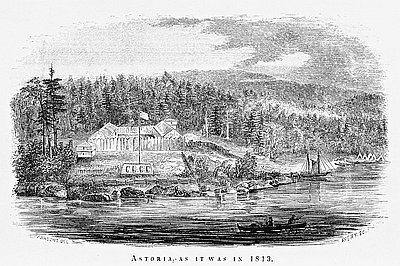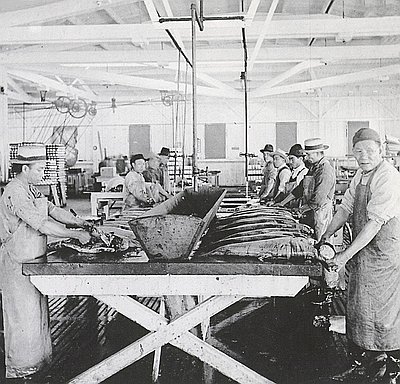- Catalog No. —
- G4294.A8 1919. W37
- Date —
- 1919
- Era —
- 1881-1920 (Industrialization and Progressive Reform)
- Themes —
- Trade, Business, Industry, and the Economy, Transportation and Communication
- Credits —
- Oregon Historical Society
- Regions —
- Coast Columbia River
- Author —
- Unknown
Port of Astoria - Astoria-Warrenton District
In 1919, the Port of Astoria began to improve its commercial maritime shipping capacity. Contractors built new piers, a flourmill, a grain elevator, and expanded the port’s warehouse space. This map also shows potential waterfront developments that were never built. In 1919, at the end of World War I, many shipbuilding companies in Astoria and other Pacific Northwest cities went out of business, and the region suffered an economic depression.
In the early 1920s, logging and salmon canning were the largest industries in Clatsop County. Logs cut from the coast range were floated on the water from Warrenton to Astoria across Youngs Bay to mills in Astoria. In 1922, the U.S. Army Corps of Engineers reported that forty-eight percent of the foreign commercial exports from Astoria was lumber, mostly destined for Asia.
In 1922, 654,000 tons of commercial goods traveled through the Port of Astoria. During the same year, the Port of Portland saw 1,340,000 tons of commercial traffic.
Written by Kathy Tucker, © Oregon Historical Society, 2002.
Related Historical Records
-
Fort Astoria, 1813
This lithograph is a reproduction of a drawing by Gabriel Franchère, published in his Journal of a Voyage on the North West Coast of America During the Years …

-
Chinese Cannery Workers near Astoria, Oregon
This stereographic image, printed by the Keystone View Company, has this description of the fish-cleaning process written on the back: “One [person] does nothing but cut off heads, tails, …

